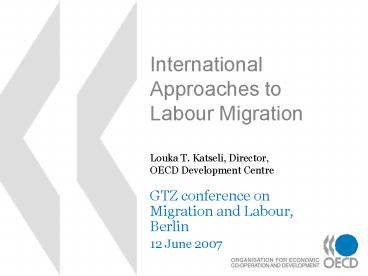International Approaches to Labour Migration - PowerPoint PPT Presentation
1 / 20
Title:
International Approaches to Labour Migration
Description:
Mutual benefits if migrants and natives are employed in jobs suited to ... partly a function of the 'disorderliness' of the current labour mobility system ... – PowerPoint PPT presentation
Number of Views:46
Avg rating:3.0/5.0
Title: International Approaches to Labour Migration
1
International Approaches to Labour Migration
Louka T. Katseli, Director, OECD Development
Centre
- GTZ conference on Migration and Labour, Berlin
- 12 June 2007
2
1
Where do interests of countries of origin and
destination concerning labour migration overlap?
2
Where do these interests diverge?
Should this be subject to negotiations?
3
3
(1) Common Interests
- Securing Jobs
- Mutual benefits if migrants and natives are
employed in jobs suited to their skills - Building Confidence
- Responding effectively to economic and social
pressures (e.g. reducing irregular and illegal
migration) - Reversing the devolution of immigrant selection
to employer traffickers and migrants - Better managing migration flows
4
Managing Global Labour MobilityWhat might an
orderly, smart, flexibly regulated system look
like?
- Put in place an Integrated Monitoring System
- Recruit workers that fill real needs
- Expand the options for legal migration (e.g.
circular migration renewable permits etc.) - Provide fair, equal and early access to labour
markets - Improve integration prospects
- Promote mobility partnerships
- Engage migrants and private stakeholders in
mobility management
5
1
Where do interests of countries of origin and
destination concerning labour migration overlap?
2
Where do these interests diverge?
Should this be subject to negotiations?
3
6
Opposed Interests
- Opposed interests are partly a function of the
"disorderliness" of the current labour mobility
system - Social pressures associated with the mobility of
low-skilled workers - Economic tensions related to mobility of the
highly skilled - A managed system could distribute fiscal and
financial burdens better
7
Mobility of low-skilled workers
- Contributes more to poverty reduction in sending
countries - Tensions look different in different places and
institutional regimes - Employment and wage effects mostly small or
beneficial - Disorderly system increases social tensions
8
Mobility of high-skilled workers
- Economic tensions in critical occupational areas
- Degree of utilisation of human resources in
sending countries determines impact - Replenishment capacity of sending countries a
critical factor
9
1
Where do interests of countries of origin and
destination concerning labour migration overlap?
2
Where do these interests diverge?
Should this be subject to negotiations?
3
10
Mobility Partnerships Why?
- Externalities generated by international
migration requires collective action (e.g. brain
drain transit countries) - Gains for all parties possible through better
management of opportunities and sharing of
responsibilities
11
Mobility partnerships What regulatory area?
- Bilateral arrangements proliferate
- Considerable regional spillovers
- Regional arrangements potential interests
converge but weak governance systems - GATS Mode 4 provision of services a powerful
instrument to organise markets
12
Regional Schemes?
- Political frameworks and legal principles missing
- Strengthening of governance structures needed
- Regional mobility instruments need to be
introduced/reinforced (e.g. regional visas) - Development co-operation and assistance schemes
need to be developed
13
Mobility partnership What role for local
communities?
- Coping strategies and integration a local
challenge - Critical interactions between migrants and local
communities need better management - Modes of financing and governance vary across
communities - Inclusive social policies needed
14
Mobility Partnerships Four levels
1. Managing mobility
15
Mobility Partnerships Whats Involved?
- (1) Mobility management
- Smart, renewable permits
- Information, communication and monitoring systems
- Simplification of admission, readmission and
deportation procedures - Specification of rights and responsibilities of
migrants - (2) Managing labour markets
- Opening up channels for legal immigration/emigrati
on - Agreed principles for regularisation procedures
- Portability of social security benefits
- Revisit codes of ethical conduct
- Phasing of benefits for immigrants
- Re-deployment of human-resources and
replenishment of labour-market needs, supported
by development assistance
16
Mobility Partnerships Whats Involved?
- (3) Managing economic adjustment
- Fiscal impact and burden sharing
- Regional integration
- Financing infrastructure investment and
improvements in social-delivery systems - Innovative financial instruments for local
development - Reducing costs and improving access for
remittances - Diaspora for development programmes
- (4) Managing social and political adjustment
- Urban and social policies
- Engagement of diaspora communities in integration
and development - Second and third generation migrants
- Legal and political rights of migrants
17
Mobility Partnerships For Whom?
- Benefits for
- Migrants
- Protection of human rights,
- Improved information,
- Lowering of costs
- Receiving countries
- Legal vs. irregular migration
- An orderly system for labour-market needs
- Sustainable co-operation and burden-sharing with
sending countries - Improved integration prospects
- Sending countries
- Smoother adjustment to emigration
- Strengthened replenishment capacity
- Improved financial benefits
- Expanded investment in human capital formation
18
Two forthcoming publications of the OECD
Development Centre
- Gaining From Migration Managing a New Mobility
System (2007) - Migration and Development Whats in it for
Developing Countries? (2007)
19
For more info www.oecd.org/dev/migration
20
Vielen Dank! Thank you for your attention!































![❤[PDF]⚡ Handbook on Transnationalism PowerPoint PPT Presentation](https://s3.amazonaws.com/images.powershow.com/10046718.th0.jpg?_=202406030511)